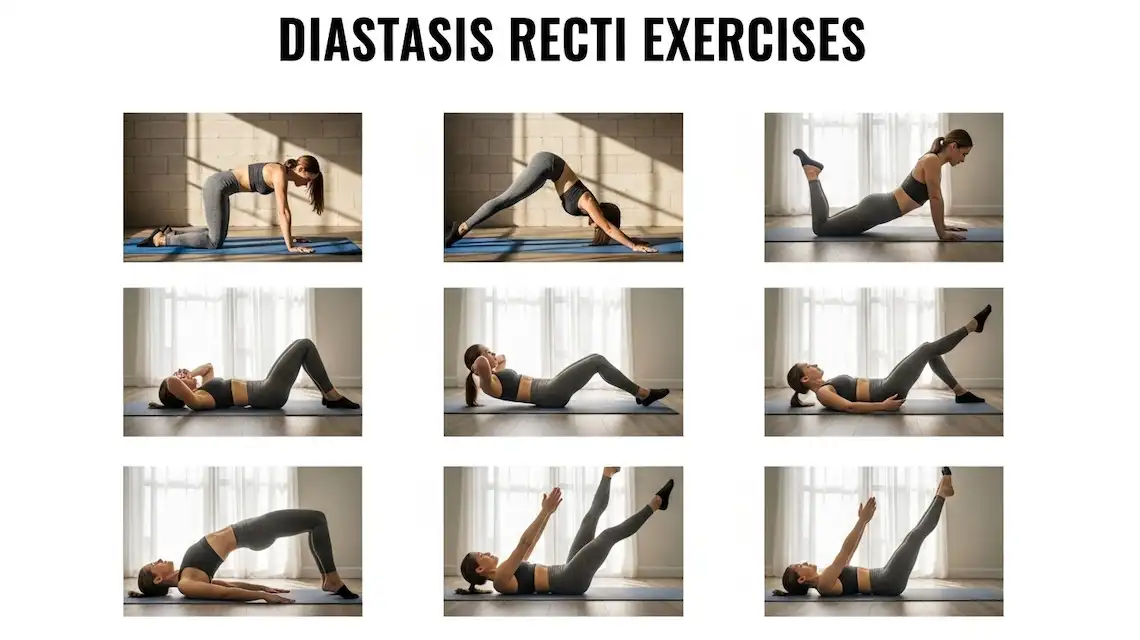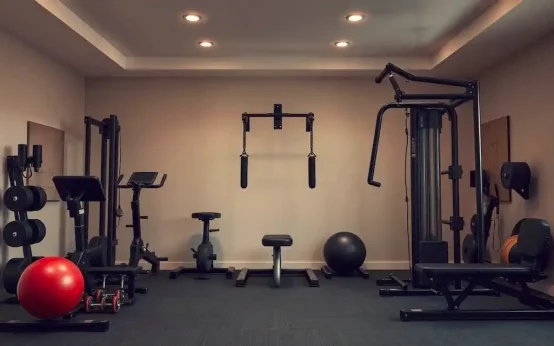Diastasis Recti Exercises can help you rebuild core strength with less pain and more confidence. Diastasis recti means the six-pack muscles separate at the midline, which can happen when pressure rises in the belly. It is common after pregnancy, but it can affect anyone who loads the core without good control, like athletes or people who lift heavy at work. Poor lifting habits and long-term belly pressure also play a role.
This guide gives you a clear plan you can start today. You will learn how to test your core, breathe better, and use beginner moves that build real strength. Progressions are included for when your body is ready. Most people notice changes in 6 to 12 weeks, but bodies heal on different timelines. The goal is better tension and function, not a perfect gap.
Keep safety first. Stop if you feel pain, bulging, or dizziness, and check with a clinician if you are unsure. Patience, smart breathing, and the right exercises go a long way.
What Is Diastasis Recti and How Do You Check It at Home?
Diastasis recti is a separation of the rectus abdominis, the front six-pack muscles. These muscles meet at a line of connective tissue down the center called the linea alba. During pregnancy, growth and hormonal changes soften this tissue. In others, high belly pressure or straining can thin the tissue and push it apart. The key issue is not only the size of the gap, it is how well the tissue can create tension when you move and breathe.
Common signs include a midline bulge or dome when you sit up, core weakness, and soreness in the lower back. Some people notice that their posture feels off or their belly looks different, like a tent shape during effort. You might also see coning in the midline during planks or sit-ups. These are signals that pressure is not managed well.
Tension quality matters more than gap size alone. A small gap with strong, springy tissue can work well for daily life and sport. A larger gap with poor pressure control can feel weak or unstable. The goal is to improve how your core manages pressure during breath and movement.
A quick safety note. If you see a hard bulge that does not reduce, have sharp pain, leaking that gets worse, or feel heavy pressure in the pelvis, see a clinician or a pelvic floor physical therapist.
Simple Diastasis Recti Self-Test (Step by Step)
- Lie on your back with knees bent and feet flat. Relax your belly.
- Place 2 to 3 fingers at your belly button, pointing toward your feet.
- Exhale, gently lift your head and shoulders just off the floor, like a tiny crunch, no straining.
- Feel for the gap and the firmness under your fingers. Test above and below the belly button too.
- Note two things, width (how many finger widths) and tension (soft, springy, or firm). Record it.
- Stop if you see doming, coning, or feel pain.
A bigger gap can still function well if tension is strong.
What Your Results Mean (Gap vs Tension)
If the tissue under your fingers feels firm or springy on the exhale, that is a good sign. It means the linea alba is taking load and your deep core is doing its job. If it feels soft and your fingers sink in, your tissue needs more support, better breathing, and practice.
Many people start with a gap of 2 to 3 fingers. That is common and not a reason to panic. The aim of Diastasis Recti Exercises is better tension, fewer doming moments, and more control in daily tasks. A small gap can remain for life and still be strong.
Track your results weekly. Test at the same time of day, in the same position. Make notes on width, tension, and any doming. Small wins add up.
Core Basics You Will Use in Every Exercise
- 360 breathing: breathe wide into ribs and back, not only the belly.
- TVA activation: on the exhale, gently draw the lower belly in, like zipping snug jeans, about 10 to 20 percent, no hard sucking in.
- Pelvic floor lifts: think lift and release of the muscles you use to stop gas or urine, keep it gentle and smooth.
These skills are the base for all Diastasis Recti Exercises.
Beginner-Friendly Diastasis Recti Exercises to Start Today
You can start a short routine 3 to 5 days per week. Move slow, keep your breath calm, and stop any move that causes doming or pain. Exhale on effort and keep ribs stacked over hips. If anything bulges or hurts, reduce the range of motion or pick an easier variation.
360 Breathing With Gentle Pelvic Floor Lifts
- How to: Lie on your back with knees bent. Inhale through your nose into your ribs and back. Exhale through pursed lips, gently lift your pelvic floor, then draw your lower belly in 10 to 20 percent. Release fully at the end.
- Dosage: 5 breaths to warm up, then 2 sets of 6 to 8 breath cycles.
- Cues: Keep shoulders relaxed, no belly bulge on inhale, no breath holding.
Transverse Ab Activation and Heel Slides
- How to: Same start position. On an exhale, engage pelvic floor and TVA, slowly slide one heel out. Keep the pelvis still. Slide back on the inhale. Alternate sides.
- Dosage: 2 to 3 sets of 8 to 10 total reps.
- Cues: Lower belly stays flat. Think zipper closing from pubic bone to navel. No back arch.
Marching and Toe Taps With a Flat Tummy
- How to: Start with feet on the floor. Exhale to float one knee up to tabletop. Inhale down. Alternate. If that feels easy with no doming, try toe taps from a 90-90 position. Tap one toe to the floor on the exhale, return on the inhale.
- Dosage: 2 sets of 6 to 10 reps per side.
- Cues: Keep ribs down, pelvis steady, slow tempo. Stop or regress if you see doming.
Pelvic Tilt and Bridge for Glutes and Core Support
- How to: Exhale to tilt the pelvis, flatten the low back gently to the floor, then lift into a small bridge. Inhale to lower with control.
- Dosage: 2 to 3 sets of 8 to 12 reps.
- Cues: Weight through heels, glutes finish the move, no rib flare, keep belly flat. Add a mini ball between knees if it helps you feel pelvic floor and TVA.
How to Progress Your Diastasis Recti Exercises Safely
Progress when your tissues can handle more tension without strain. Use simple tests to guide you. If you can move, breathe, and talk without doming, you are likely ready to add range, load, or time. Keep your wins repeatable. A small step forward that you can repeat beats a big jump that causes setbacks.
Add challenge in three ways: increase range of motion, increase time under tension, or add light resistance. Keep the core skills you learned. Exhale on effort, ribs down, zip up low belly, and relax fully between sets.
Readiness Checks Before You Level Up
- You can do 10 slow reps with steady breathing and no doming.
- Your lower back stays calm, no pinching or cramps.
- You can talk in full sentences during sets, no breath holding.
- Your gap feels the same or tighter during the exhale.
If any fail, stay at your current level or reduce range until signs improve.
Dead Bug and Bird Dog Progressions
- Dead bug: From 90-90 legs and arms up, exhale and reach one arm and the opposite leg long. Inhale to return. Start with a short range, grow it over time.
- Bird dog: On hands and knees, exhale to reach opposite arm and leg, keep hips level. If you see doming, try only legs or only arms.
Dosage: 2 to 3 sets of 5 to 8 reps per side.
Cues: Zip up the low belly on the exhale, keep ribs down, move slow.
Side Plank Variations and Anti-Rotation Work
Start with a side plank on knees for 10 to 20 seconds. Progress to staggered feet, then a full side plank if your tension stays good. Add anti-rotation moves like a tall-kneeling Pallof press with a band.
Dosage: 2 to 3 sets of 2 holds per side, 20 to 30 seconds. Pallof press, 8 to 10 reps per side.
Cues: Long body line, lift from the bottom waist, no rib flare, breathe steadily.
Return to Planks, Push-Ups, and Light Lifting
Rebuild in stages. Start with elevated planks on a bench, then lower the height as control improves. Try incline push-ups, then move to the floor. For lifting, exhale to brace gently before you move the weight. Avoid holding your breath hard, also known as the Valsalva. Stop if you see doming or feel pelvic pressure.
Dosage: 2 sessions per week for these skills, 2 to 3 sets, low to moderate effort.
Common Mistakes, What to Avoid, and a Simple Weekly Plan
Small changes in daily habits can protect your core while you get stronger. Avoid moves that spike pressure early. Use breath and posture to guide every task. Your body will thank you for going slow and steady.
Movements to Avoid Early and Easy Fixes
Avoid at first: crunches, sit-ups, heavy lifting that makes you strain, full planks if they cause doming, hanging leg raises, deep backbends, forceful twisting, and breath holding.
Fixes: roll to your side to get out of bed, exhale on effort for all tasks, use an elevated surface for planks and push-ups, hug a pillow when you cough or sneeze. If a binder is used, wear it short term and do not overtighten.
Daily Life Tips for a Healing Core
- Posture: stack ribs over hips when standing or feeding a baby.
- Lifting: bring the load close, exhale and zip up, then stand.
- Bathroom habits: manage constipation with water, fiber, and light movement, no straining.
- Walking: 10 to 20 minutes most days supports healing.
Small, steady steps beat long, hard workouts early on.
Sample 2-Week Schedule and Recovery Basics
- Week 1: Mon beginner set, Tue walk and breath work, Wed beginner set, Thu rest or gentle mobility, Fri beginner set, Sat walk, Sun rest.
- Week 2: Mon beginner set, Tue walk plus 1 progression move, Wed rest, Thu beginner set, Fri add a second progression move if ready, Sat walk, Sun rest.
Recovery basics: aim for 7 to 9 hours of sleep, protein at each meal, hydrate, and keep stress in check. If postpartum, wait for medical clearance and watch for bleeding changes.
When to See a Pelvic Floor PT and What to Expect
Seek help if you have pelvic pressure or bulging, leaking that does not improve, pain, a hernia-like bulge, or no progress after 8 to 12 weeks. A pelvic floor PT can assess your breath, pressure, and any scar tissue, then give a custom plan. Some gap can remain and still be strong if tension and function are good.
Conclusion
You now have a simple plan. Test your core, learn 360 breathing, start with the beginner Diastasis Recti Exercises, and progress when the signs say yes. Use daily tips to protect healing and track your tension, reps, and photos each week. If you feel stuck or worried, a pelvic floor PT can guide you.
Strong changes come from small, steady actions. Start with 10 minutes today. Pick two exercises from the beginner list and build the habit. Your core is adaptable, and with patience and smart practice, you can restore function and feel more at home in your body.
Related post: Mindfulness and Breathing Exercises
Diastasis Recti Exercise FAQs: What Works, What to Avoid
What is diastasis recti?
Diastasis recti is a gap in the abdominal wall. The linea alba thins and the rectus muscles drift apart. It is common in pregnancy, but anyone can have it.
How do I know if I have it?
Lie on your back with knees bent. Lift your head slightly and feel the midline at, above, and below the navel. A gap wider than two finger widths, or a soft trench, suggests diastasis recti. Function matters too. If you see doming, coning, or bulging, get it checked.
Can exercises actually help close the gap?
Yes. Targeted work can improve tension and function. The goal is a firm midline and good pressure control, not a perfect zero gap.
Which exercises are safe to start with?
Start slow and focus on deep core. Good options:
- Diaphragmatic breathing with rib expansion
- Pelvic floor contractions paired with exhale
- Transverse abdominis activation, draw belly in gently
- Heel slides or bent-knee marches with ribs down
- Dead bug progressions with slow tempo
- Side-lying clam shells and hip abduction
- Bridge with core set, avoid rib flaring
Which moves should I avoid at first?
Skip anything that causes doming or strain. Common culprits:
- Full sit-ups, crunches, bicycles
- Long planks and push-ups
- Heavy lifts with breath holding
- Double leg lowers, jackknives, roll-ups
- Deep backbends or aggressive twists
How often should I do diastasis recti exercises?
Short, daily sessions work best. Aim for 10 to 20 minutes, five to six days per week. Focus on quality, slow reps, and calm breathing.
When can I start after giving birth?
Start gentle breathing and pelvic floor work within days if you feel ready. Add core activation and light moves after your provider clears you, often around two to six weeks. Go slower after a C-section.
Can men get diastasis recti?
Yes. It can happen with weight gain, heavy lifting with poor form, or chronic strain. The same exercise principles apply.
Will a belly binder fix it?
A binder can offer short-term support and comfort. It does not repair the tissue. Use it along with proper exercise and breathing.
How long does recovery take?
Timelines vary. Many see progress in 8 to 12 weeks with steady work. Larger gaps, hernias, or repeated strain can take longer.
How should I breathe during exercises?
Inhale through the nose, expand ribs sideways. Exhale through pursed lips, gently lift pelvic floor, then wrap the lower belly. Do not brace hard or hold your breath.
What does “coning” mean and why does it matter?
Coning is a ridge or bulge along your midline during effort. It signals poor pressure control. Stop the move, reset your breath and core, or choose an easier version.
Can I ever do planks or crunches again?
Often yes, once you control pressure and avoid coning. Start with incline planks or short holds. Test small crunch lifts with perfect form. If you dome, regress and rebuild.
Is yoga or Pilates safe with diastasis recti?
Yes, with smart choices. Favor breath-led core work, side-lying moves, and hip strength. Avoid deep backbends, roll-ups, and strong twists until you have midline control.
How do I lift weights without making it worse?
Use lighter loads at first. Exhale on exertion, brace gently, and keep ribs stacked over pelvis. Avoid breath holding. If you see coning, reduce load or change the move.
Do I need physical therapy?
If you have pain, pelvic floor symptoms, a large gap, or slow progress, see a pelvic health physical therapist. They can tailor cues, progressions, and daily habit fixes.
Will surgery be necessary?
Surgery is rare for exercise-only cases. It is considered for very large separations, hernias, or persistent symptoms after conservative care. A surgeon and PT can guide the decision.
What daily habits help healing?
- Roll to your side to get out of bed
- Keep ribs stacked over pelvis when standing
- Use an exhale to lift, push, or pull
- Manage constipation and chronic cough
- Choose supportive, not overly tight, clothing
What results should I track?
Look for less doming, stronger exhale control, and better posture. Check the gap and tissue firmness weekly. Note improvements in daily tasks, like lifting and carrying.




 Beginner Cardio Workout at Home
Beginner Cardio Workout at Home  10 Stretching Exercises to Increase Height
10 Stretching Exercises to Increase Height  Menopause Workout: A Simple, Strong Plan
Menopause Workout: A Simple, Strong Plan  Best Home Gym Workout Equipment
Best Home Gym Workout Equipment  Exercise Tips Help You Look Great for Your Age
Exercise Tips Help You Look Great for Your Age  How to Stay Active With Back Pain
How to Stay Active With Back Pain